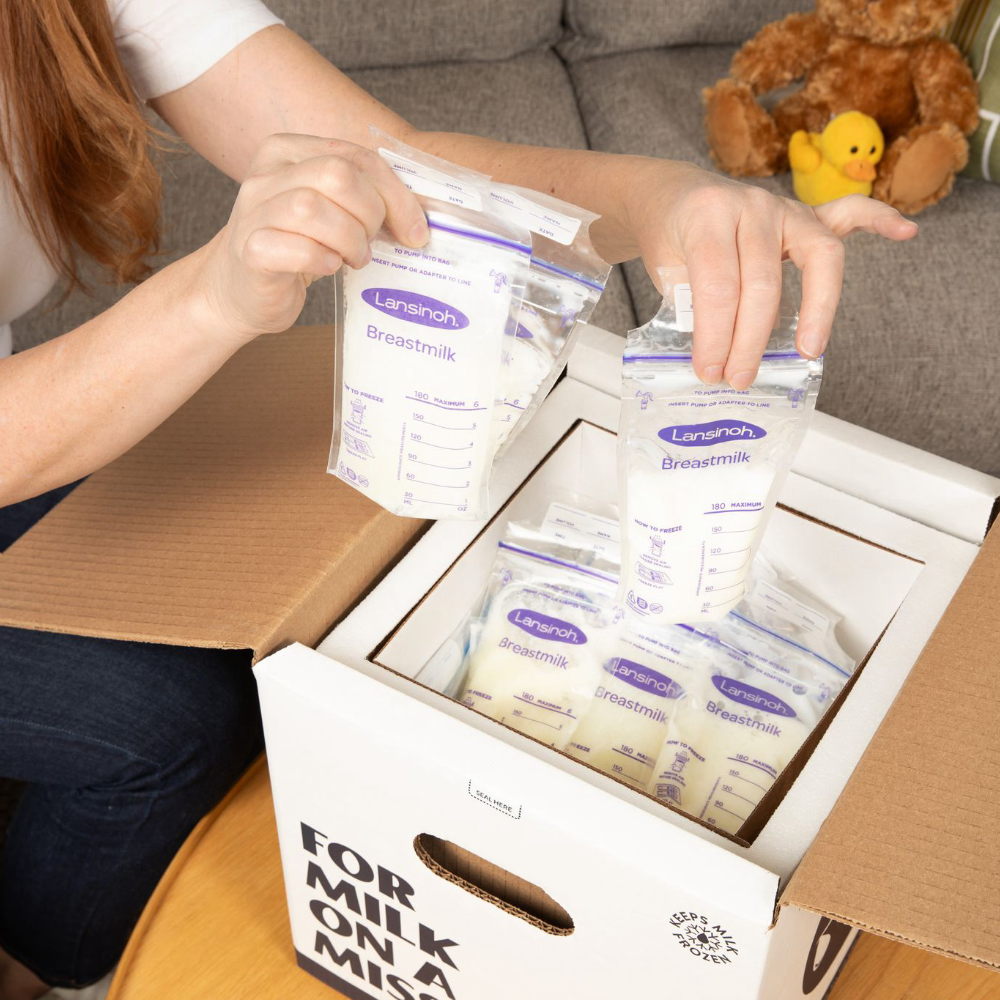Breast Milk for Surrogacy: The Complete Guide for Intended Parents
For Intended Parents, deciding how to feed your baby can be one of the first major decisions after birth. Many families want to provide breast milk provided by their surrogate while others explore donor milk, formula, or a blend of both (known as "combo feeding").
This guide breaks it all down: The benefits of breast milk, your baby feeding options, how breast milk shipping works, and what to expect with Milk Stork for surrogacy.
Whether you’re a surrogate preparing to pump or an Intended Parent preparing to receive breast milk, this page has everything you need.
Table of Contents
- Why Breast Milk Matters for Intended Parents
- The Benefits of Pumping for Surrogates
- Breast Milk Options for Surrogacy
- Your Baby Feeding Options, Side by Side
- Breast Milk Timeline for Surrogacy
- How Breast Milk Shipping and Transport Actually Works
- Price Ranges: What to Expect
- Why IPs and Surrogates Choose Milk Stork
- FAQs – Milk Stork for Surrogacy
- Resources and Next Steps
Why Breast Milk Matters for Intended Parents
Breast milk is considered the gold standard for infant nutrition by organizations like the World Health Organization (WHO) and the Centers for Disease Control and Prevention (CDC). Here’s why many families make breast milk part of their baby-feeding plan:
-
Breast milk provides complete nutrition. Breast milk naturally contains the right balance of proteins, fats, and carbohydrates for newborn growth.
-
Breast milk increases immunity. Breast milk delivers antibodies and live cells that help defend against infections and illness.
-
Breast milk is gentle on digestion. Breast milk is easier to digest than formula, with enzymes and prebiotics that promote gut health.
-
Breast milk promotes healthy growth. Breast milk provides the ideal balance of nutrients to support steady physical development through the first year of life.
-
Breast milk lower the risk of illness. Babies fed breast milk have reduced risk of ear infections, respiratory illnesses, and sudden infant death syndrome (SIDS).
The Benefits of Pumping for Surrogates
1. Faster Postpartum Recovery
Pumping triggers the release of oxytocin, which causes the uterus to contract and return to its pre-pregnancy size more quickly, according to the American College of Obstetricians and Gynecologists (ACOG).
2. Reduced Risk of Breast and Ovarian Cancers
Pumping lowers cancer risk, according to University of Texas' MD Anderson Cancer Center. It does this by reducing exposure to estrogen, a hormone known to play a role in breast cancer cell growth, and by shedding breast tissue, which can help remove cells with potentially damaged DNA.
3. Quicker Weight Loss
Producing and pumping breast milk burns an extra 450-500 calories per day, according to ACOG. Surrogates may find that they lose pregnancy weight faster when they pump.
4. Additional Compensation
Surrogates who provide milk to Intended Parents are compensated for their time, usually on a weekly basis. The arrangement can extend for weeks to years after the birth.
Breast Milk Options After Surrogacy
Breast milk provides complete nutrition and boosts your baby's immune system. As Intended Parents, there are several ways to incorporate breast milk into your baby-feeding plan:
-
Surrogate-provided milk. Some surrogates choose to pump and provide milk after birth for an additional fee, either for a few weeks or longer.
-
Donor milk: Families may use breast milk from a milk bank or a screened, private milk donor.
-
Formula: A safe and reliable option many families use exclusively or in combination.
-
Combo feeding: Many families mix breast milk (from surrogate or donor) with formula to balance immune benefits with convenience.
Every family’s choice looks different. The important part: your baby is nourished, and you feel supported in the process.
Breast Milk Timeline for Surrogacy
Your surrogate's body will follow the same breast milk timeline as other birthing individuals.
Day 0–3: Colostrum
- What it is: Thick, golden “first milk” that’s small in volume but rich in immune-boosting antibodies and nutrients.
- Why it matters: Colostrum is often called “liquid gold.” A single teaspoon can provide powerful protection for your newborn.
- Volume: Only a few teaspoons at a time.
Day 3–7: Transitional Milk
- What it is: Breast milk shifts from colostrum to a creamier, higher-volume supply.
- Why it matters: The balance of fat, protein, and lactose evolves to fuel rapid newborn growth.
- Volume: Increasing noticeably. Pumping sessions begin yielding more ounces.
Week 2–4: Mature Milk
- What it is: Fully established milk supply. Looks thinner at the beginning of a pump (foremilk) and creamier toward the end (hindmilk).
- Why it matters: Provides complete nutrition, consists of proteins, fats, vitamins, and antibodies.
- Volume: Regular pumping yields enough milk for consistent shipments.
Beyond 1 Month: Stable Supply
- What it is: Breast milk production adjusts to a predictable rhythm based on pumping schedule.
- Why it matters: Consistency allows Intended Parents to plan breast milk storage and feeding confidently.
- Volume: Varies by surrogate, but typically stabilizes to steady milk shipments.
Want to learn more about breast milk basics? Check out our blog post "Breast Milk Basics for Intended Parents."


How Breast Milk Shipping and Transport Actually Works
Every drop of breast milk is hard-earned. It’s called liquid gold for a reason! To keep it safe for your baby, it must stay properly refrigerated or frozen.
-
Frozen breast milk is most common for shipments because it stays safe longer in transit and is easier to store once received.
-
Refrigerated breast milk can be shipped too, but requires faster turnaround and more frequent coordination.
-
Combo feeding families may request smaller, less frequent shipments if breast milk is being supplemented with formula.
Milk Stork’s surrogacy kits are designed to make breast milk shipping between surrogates and Intended Parents simple.
What’s in a Milk Stork surrogacy kit:
-
A medical-grade cooler that keeps breast milk frozen up to 96 hours, without dry ice!
-
Prepaid FedEx Priority Overnight labels
-
Packing supplies and instructions
$200-300
For starter or single shipment kits
Send smaller amounts of milk more frequently
$300-500
Mid-sized, recurring shipments
Send repeat milk shipments in a mid-sized cooler
$900+
Comprehensive Surrogacy Bundles
Send recurring, large quantities of milk over several months
Exact pricing depends on the kit type and number of shipments you need.
Trusted by Families Worldwide
Safe & Secure Shipping
Flexible Options Tailored for Surrogacy
Transparent Pricing
Gold Standard in Breast Milk Shipping
FAQs – Milk Stork for Surrogacy
-
How do surrogates send breast milk to Intended Parents?
Surrogates can ship breast milk using temperature-controlled coolers designed to keep breast milk frozen in transit. With Milk Stork, surrogates pump, pack frozen breast milk into a pre-labeled cooler, and schedule a pickup or drop it off at a carrier location. No dry ice is required, and breast milk stays frozeb for up to 96 hours, ensuring it arrives safely for your baby.
Various factors affect milk safety. Alternative guidance may be appropriate based on your individual circumstances and other factors. This information is not a substitute for your medical provider's advice.
-
How much does it cost to ship breast milk after surrogacy?
The cost of shipping breast milk depends on how much milk is being sent and how often. On average, families can expect to spend a few hundred dollars per shipment. With Milk Stork’s surrogacy products, families can expect to spend between $200-300 per cooler for single shipments, $300-500 for mid-sized, recurring shipments, and $900+ for recurring, large quantities of breast milk over several months.
-
Should my surrogate send all the breast milk at once, or in smaller batches but more often?
It's totally up to you and your surrogate. Shipping large quantities is more cost effective, but as Intended Parents, you may want your baby to receive breast milk early on, rather than waiting for your surrogate to pump enough breast milk to fill a large Stash cooler.
-
I don't know how much breast milk my surrogate will pump. Which cooler size should I choose?
The Surrogacy Intro Bundle is perfect for families who are just starting their milk sharing journey and want to begin shipments with smaller quantities. You can always transition to a larger Stash Surrogacy Bundle later after milk supply is established.
-
Does breast milk expire?
Breast milk is perishable, so it's important to follow proper breast milk cold storage guidelines to ensure its safety for your baby.
- Frozen breast milk is safe to use within 12 months. (The American Academy of Pediatrics Milk Storage Guidelines)
- Thawed breast must be used within 24 hours if thawed overnight in the refrigerator. (CDC Breast Milk Storage and Preparation)
Do not refreeze thawed breast milk, and discard leftover milk from feedings after 2 hours.
Please note that various factors affect milk safety. Alternative guidance may be appropriate based on your individual circumstances and other factors. This information is not a substitute for your medical provider's advice. -
How long will do Milk Stork coolers keep breast milk frozen?
Up to 96 hours when packed according to the cooler's instructions. Breast milk must be frozen solid before packing.
Please note that various factors affect milk safety. Alternative guidance may be appropriate based on your individual circumstances and other factors. This information is not a substitute for your medical provider's advice. -
Do Milk Stork coolers require dry ice?
No. Milk Stork’s coolers are designed to ship without dry ice and require no activation or prep. Just make sure the breast milk is frozen solid and follow the cooler's packing instructions.
-
Can I use Milk Stork outside of the U.S.?
Yes, Milk Stork currently serves 183 countries.
Resources and Next Steps
Feeding after surrogacy doesn’t have to be complicated. Whether you choose breast milk from your surrogate, donor milk, formula, or combo feeding, Milk Stork is here to support your family and make logistics seamless.
- Read the Blog: Breast Milk Basics for Intended Parents
- Explore Milk Stork's Surrogacy Solutions
- Download the Surrogacy Breast Milk Checklist for Intended Parents
- Learn More about Combo Feeding (by Simplifed)
- Contact Milk Stork Customer Care for International Shipping Questions



.png?width=2250&height=1500&name=Baby%20Feeding%20Options%2c%20Side%20by%20Side%20(2).png)